After 10 years behind bars, John Dillinger went on a year-long bank-robbing spree that captured America's imagination.

Federal Bureau of InvestigationA mugshot of John Dillinger.
The bank robber and gangster John Dillinger didn’t live a long life, but he spent almost all of his 31 years in some kind of trouble.
He quickly gained notoriety as one of America’s leading celebrity criminals, becoming a legendary media character who commanded the entire country’s attention.
In the months he spent terrorizing the American Midwest, John Dillinger helped reshape how federal law enforcement investigates interstate crimes for nearly a century to come.
But like most famous criminals, John Dillinger’s death was as violent as his dealings.
John Dillinger: A Troubled Boy From The Start
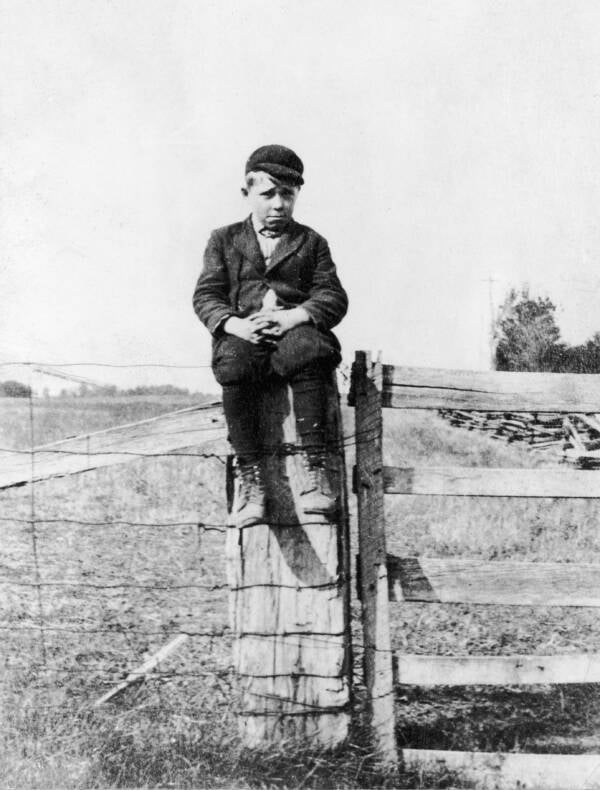
Hulton Archive/Getty ImagesFuture FBI “Public Enemy No. One” John Dillinger as a young boy, seated on a fence post on his father’s Indiana farm.
John Dillinger was born in Indianapolis in 1903. His parents already had a 14-year-old daughter, Audrey, and his mother passed away in 1907, when John was three.
Back then, it was customary for widowed men to find alternative arrangements for their children, so Dillinger’s father quickly married off Audrey and sent John to live with the newlyweds.
But a few years later, after his father remarried and Audrey’s family grew too big to manage, John moved back in with his dad.
By this point, the young Dillinger was already a handful. He bullied kids at school and became the lead of a neighborhood gang, with whom he stole coal from the Pennsylvania Railroad. And thus began his first run-in with the law: When some of the housewives he sold coal to ratted out him and his co-conspirators, Dillinger got a talking to from a local judge.
The judge might have thought the lecture was enough to set him straight, but Dillinger’s numerous future crimes would ultimately prove him wrong.
Dillinger’s Run-In With The Law
John Dillinger dropped out of school as a teenager and worked at a machine shop in Indianapolis, spending his spare time shoplifting and drinking. Afraid the city was corrupting his boy, Dillinger’s father moved the family to rural Mooresville, Indiana.
The move to farm country came too late for Dillinger. By this point, he molded into a young man who always seemed to be looking for trouble. He fell in love with a young woman — Frances Thornton — but her stepfather’s disapproval brought their affair to an end.
In 1923, at age 19, he boosted a car in Mooresville and took a joy ride around Indianapolis. When the police were hot on his trail, he escaped capture on foot and enlisted in the Navy to avoid prosecution.
Predictably, he had a problem with maintaining discipline and following orders, so just a few months after joining, he deserted while his ship was docked at Boston Harbor. He ultimately received a dishonorable discharge and went back home to Indiana.
Cleaning Up The Act And Marrying
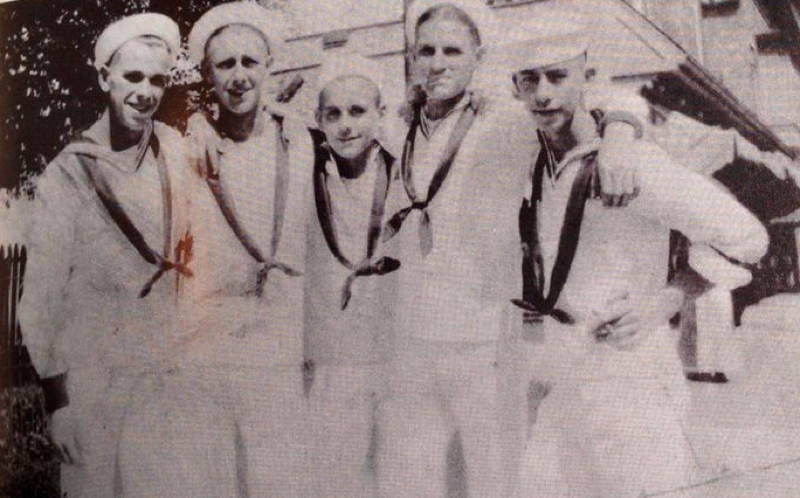
johndillingerhbrA Young Dillinger (far left) during his time in the U.S. Navy.
Back in Mooresville, 20-year-old John Dillinger bounced around from job to job and from woman to woman. His father had become a member of the local clergy, and the family was getting fairly well-known around town.
He met 16-year-old Beryl Hovious and the two became attached, marrying on April 12, 1924.
Despite appearances, however, Dillinger had not changed his ways. When he made it clear he couldn’t support his wife, Dillinger turned to the only thing he knew: crime.
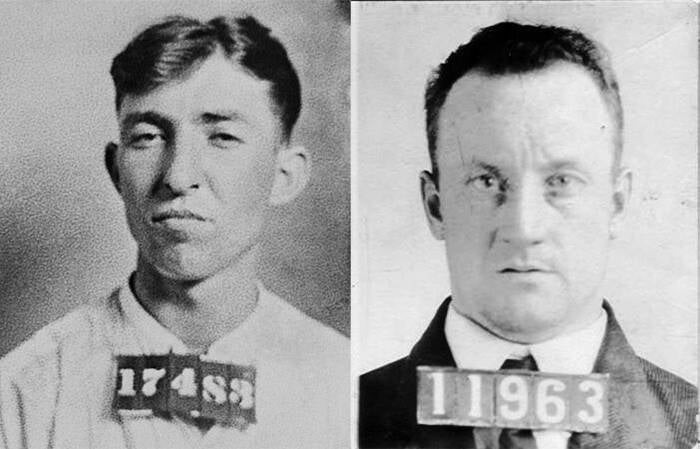
Wikimedia CommonsEddie Green (left) and John Hamilton (right), two members of Dillinger’s gang. Hamilton was one of eight men Dillinger met during his prison stint.
Not long after his wedding day, Dillinger and an associate, Ed Singleton, waited behind a church. They knew that Frank Morgan, an old grocery store owner in town, walked the same route home every night.
As Dillinger later recounted, documented in the book John Dillinger: The Life and Death of America’s First Celebrity Criminal “When [Morgan] came along I jumped out from behind the building and hit him twice on the head with a bolt which I had wrapped up in a handkerchief. He then turned and grabbed a revolver which I had in my hand. The gun was discharged when I jerked it away from him, the bullet entering the ground. We then ran.”
The Mooresville Times’ account of the story mirrored Dillinger’s — with the added detail that Morgan’s wounds required 11 stitches.
Dillinger’s father talked him into confessing, pleading guilty, and asking for leniency. Instead, the court threw the book at him.
Ten years later, Indiana Gov. Paul V. McNutt recounted Dillinger’s harsh sentence, as written in the book Criminals and Folk Heroes: “The judge and the prosecutor took him out and assured him if he would tell certain things they would let him off with a lighter sentence. They didn’t keep their word. They gave Dillinger 10 to 20 years while his partner in crime, Edgar Singleton, got two to 14 years and was released at the end of two years. This made a criminal out of John Dillinger.”
Years later, Dillinger wrote a letter to his father: “I know I have been a big disappointment to you but I guess I did too much time, for where I went in a carefree boy, I came out bitter toward everything in general…If I had gotten off more leniently when I made my first mistake this would never have happened.”
To add insult to injury, Dillinger’s first prison physical included a diagnosis of gonorrhea.
He wound up serving nine and a half years. In 1929, five years into his sentence, John Dillinger’s wife Beryl got a divorce, unable to handle the separation.
Dillinger Gets A Taste Of Freedom, And Another Opportunity To Commit Crimes

Wikimedia CommonsJohn Dillinger sporting his signature grin.
Did Dillinger’s length sentence really make him a criminal? Well, before his incarceration Dillinger committed a smattering of one-off petty crimes; after nine and a half years milling with convicts in the Indiana State Prison system, he promptly committed a string of high-stakes, high-profile bank robberies.
Resenting society and embittered by the harshness of his sentence, John Dillinger got serious about learning the criminal trade. Surrounded by several of Indiana’s worst bank robbers and strong-arm men, Dillinger spent most of his 20s learning as much as he could about organizing stick-ups and evading the law.
During this time, Dillinger minded his manners and picked the brains of several notable criminals, including the likes of Harry Pierpont, Charles Makley, Russell Clark, and Homer Van Meter.
But then came a shift. In the early 1930s, funding cuts coupled with the doubling of the prison population led to immense strain on the Indiana state penal system. Families who’d lost everything began stealing and pilfering out of desperation. In 1933, a new parole board convened, and it was looking to free more inmates than before.
Dillinger wrote his sister, Audrey, and asked her and their father to help Johnnie plead his case for early release. The family obliged and circulated a petition that got 188 signatures. On May 10, 1933, with the blessing of Gov. McNutt, 29-year-old John Dillinger finally got paroled.
Meanwhile, the Great Depression was still in full force, and work of any kind was almost impossible to find, even for the most dedicated and hard-working men — it was the perfect storm for men like John Dillinger.
John Dillinger: The Bank Robber
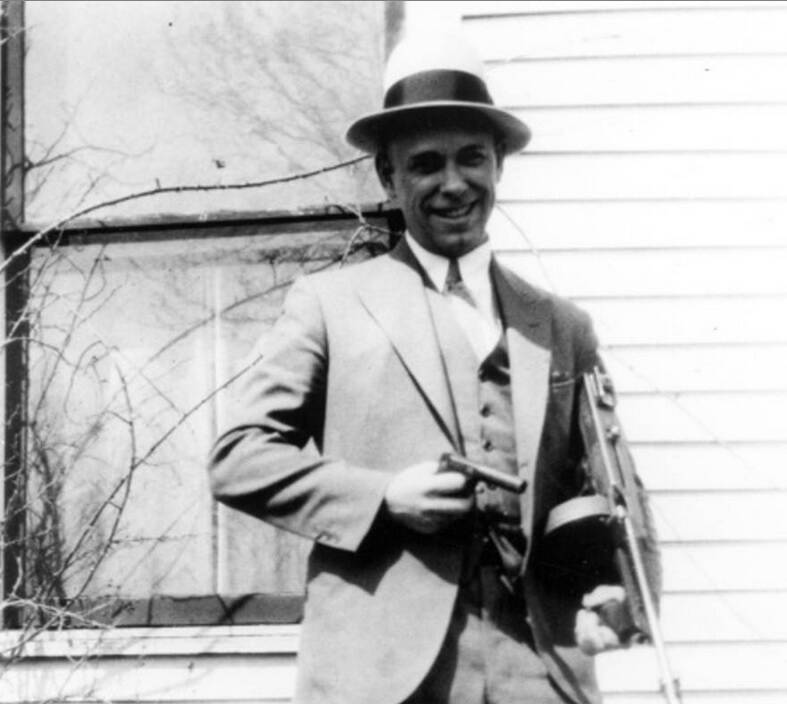
W. H. Bass/Indiana Historical SocietyJohn Dillinger with machine gun and pistol in hand.
At Dillinger’s parole hearing, he vowed to return to his family’s farm and work the land after his release, all of which was a lie.
Upon his release, Dillinger immediately turned to the most lucrative crime he could think of: bank robberies. Just a month after returning home, he gathered a crew of men who he heard about in prison — Paul “Lefty” Parker, William Shaw, and Shaw’s friend Noble Claycomb — and robbed $10,000 from the New Carlisle National Bank in Ohio. They camped out in the bank overnight, tied up two employees the next morning, and forced a third employee to open the safe for them.
Rather than coasting on that score, which equated to almost $250,000 today, Dillinger and his gang moved onto another bank — this time Bluffton. This bank had been robbed before, however, so the team only collected $2,000 and had to fire shots through the windows to escape.
On September 22, just a couple weeks after stealing more tan $21,000 from a bank in his hometown of Indianapolis, Dillinger was arrested by Dayton, Ohio police.
Police captured him in the boarding house where his girlfriend, Mary Longnaker, lived with “four pistols, $2,600 in cash, quantities of rifle and shotgun shells, detailed notes explaining the speediest ways to escape from various cities and sacks full of carpet tacks,” according to that day’s edition of the Dayton Daily News. Longnaker’s landlady had snitched on them.
As a repeat felon, there was no way Dillinger could avoid prison this time.
Escape And Adventure
In addition to the cash and guns John Dillinger was carrying at the time of his arrest, he had with him a cryptic document and a crudely drawn map. Dillinger refused to say what it was, but police believed it was a prison escape plan.
Dillinger later used that plan to smuggle shotguns and rifles to break his associates out of jail only mere days after their arrest.
To return the favor, three of the escapees came back to the Lima, Ohio jail on October 12, this time disguised as Indiana State Police officers. They told the sheriff that they were there to return Dillinger to an Indiana penitentiary for violating his parole.
When the sheriff asked them for some identification, one of the convicts pulled a gun, shot him, and beat him until he was unconscious. They then fished out the key to Dillinger’s cell and broke him out. The gang then fled back to Indiana.
Hoover, The Bureau Of Investigation, And Getting Caught Once Again
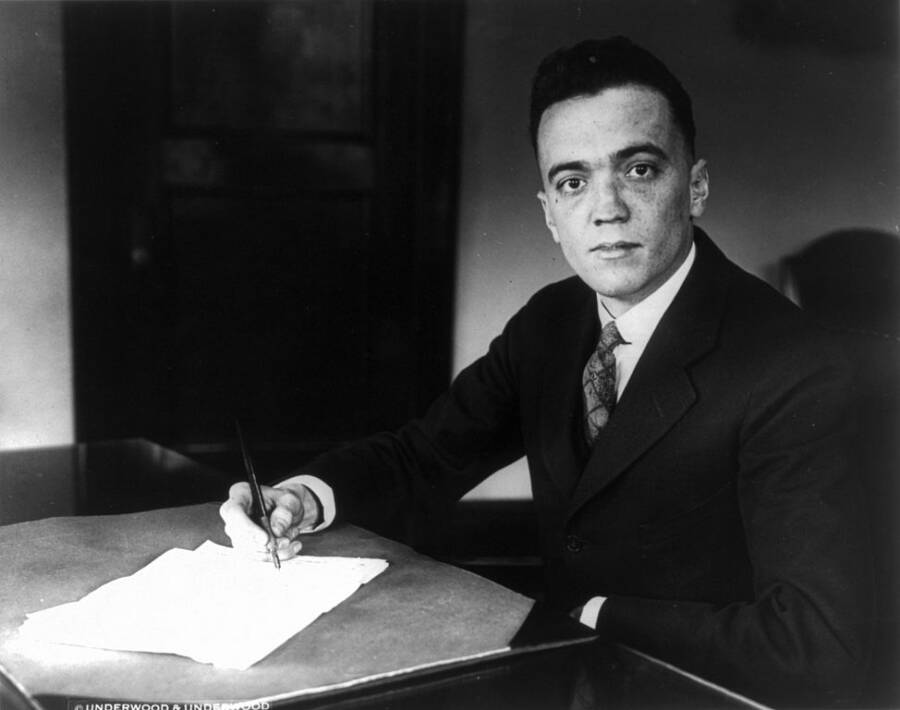
A young J. Edgar Hoover, the FBI’s founder and director for nearly 50 years. The Dillinger case was an opportunity for Hoover to expand the FBI’s power.
By crossing a state border while fleeing a crime, the Dillinger Gang had committed an interstate offense. That, plus the death of the sheriff, drew the attention of Federal Bureau of Investigation director, J. Edgar Hoover.
After the gang robbed at least four more banks in different Midwestern states, the FBI coordinated with local law enforcement to ensnare the outlaws.

Keystone/Getty ImagesDillinger poses playfully with Lake County, Indiana prosecutor Robert Estill and Sheriff Lillian Holley at the jail in Crown Point, Indiana.
In January 1934, the Dillinger Gang robbed $20,000 from a bank in Indiana and fled to the southwest. The FBI had tipped off police jurisdictions along the route about the fugitives. Their intelligence paid off in Tucson, Arizona, where police arrested Dillinger 10 days after the robbery.
The chief of the Indiana State Police personally transported Dillinger back to Indiana to answer charges there, where they locked him in the “escape-proof” Crown Point jail. That is, until Dillinger reportedly carved a fake gun out of wood and used it to successfully escape.
He quickly reconnected with his gang, which now included the infamous cop-killer Baby Face Nelson. Now the subject of a nationwide manhunt, the crew holed up in Minneapolis and within a single week robbed banks as far apart as South Dakota and Iowa.
No Rest For The Wicked
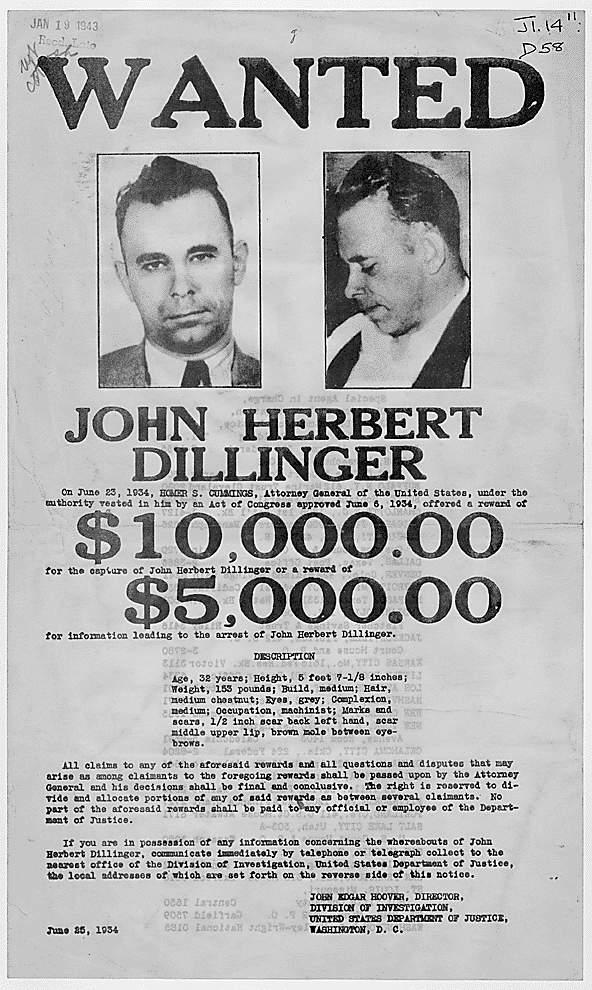
Federal Bureau of InvestigationAn FBI wanted poster for Dillinger.
By March 1934, Dillinger had moved into an apartment in St. Paul, Minnesota, reunited with an girlfriend, Evelyn Frechette.
Their nosy landlady took an interest in the couple, and on March 30, she had enough to go to the FBI field office and report her suspicions. The Bureau sent a pair of agents to check out her story, who were soon confronted by an enraged Dillinger bursting out the door and firing a tommy gun from the hip.
The agents returned fire, hitting Dillinger in the leg. The robber limped away, fleeing back to Mooresville with Frechette and holing up at the family home. After a week of recovery, Dillinger and his associates set out again toward Ohio.
It’s not entirely clear what they meant to do, but they were carrying multiple guns and a bullwhip. Later testimony indicated they were looking for one of Dillinger’s former lawyers to work off an old grudge. Unfortunately for them, on April 7, they accidentally rear-ended a couple on the road.
When their vehicle description was read over the radio, the local FBI swarmed the site, only to find the gang’s empty car on the side of the road.
Desperate Times Call For Desperate Measures

Federal Bureau of InvestigationThe many faces of John Dillinger.
Two days later, on April 9, Frechette went to a meet a potential new landlord in Mooresville.
Smelling trouble, the robber held back in the car and sent her in first. As soon as she walked into the bar, FBI agents put her in handcuffs and hauled her off. She would never see Dillinger again.
He tried to rescue her, even using a hostage law enforcement officer to break into a police armory for bulletproof vests. However, the plan was eventually abandoned.
The wanted gangster moved to Michigan’s Upper Peninsula and then Chicago, taking the alias of Jimmy Lawrence.
By now, the FBI had a dedicated Dillinger task force and called him “Public Enemy No. 1.” They even managed to find his abandoned car in the city. The FBI knew he was in town, but for several months the team worked without any leads.
Then, near the end of May, in another attempt to evade law enforcement, the gangster paid a plastic surgeon $5,000 to alter his appearance. The surgeon removed some of his moles and scars, filled in his chin cleft, and burned his fingerprints off.
The few alterations apparently were enough for him to pass by a couple of Dillinger Squad agents undetected at a Cubs game. Around this time, he also started dating the teenage runaway-turned-prostitute, Polly Hamilton.
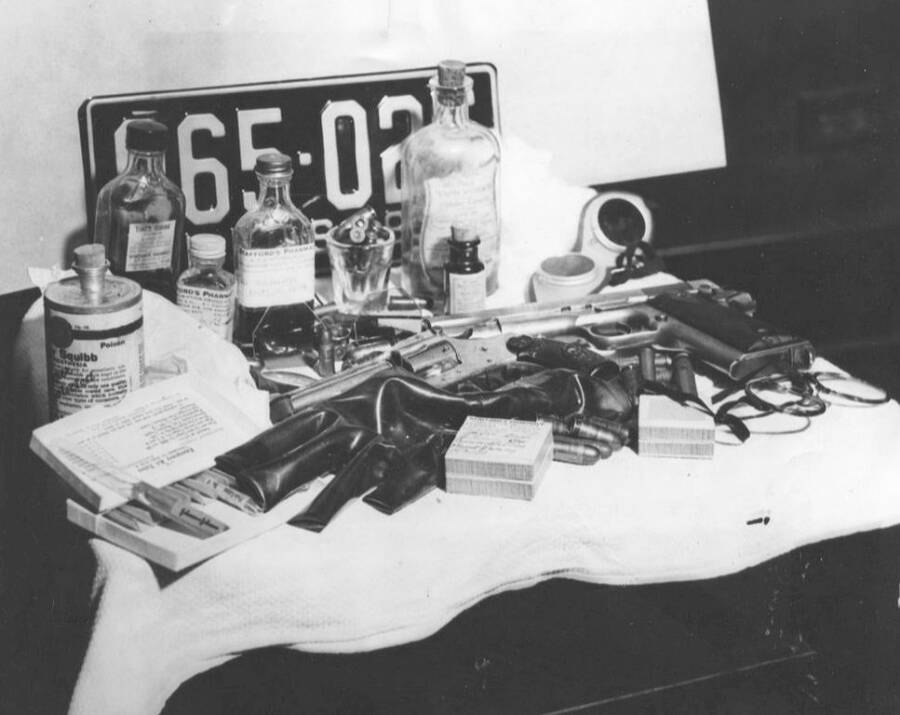
Wikimedia CommonsThe medical equipment used by a surgeon during Dillinger’s plastic surgery.
John Dillinger’s Death: The End Of America’s Public Enemy Number One
During their brief time together, Dillinger and Hamilton saw each other daily. On July 22, Dillinger suggested they see a show at the Biograph Theater, just around the corner from their hideout.
What he didn’t know was that Hamilton’s madam, Ana Cumpănaș, or Anna Sage, a Romanian immigrant facing deportation for running a brothel in Gary, Indiana had betrayed him.
Though Dillinger was still going by his alias, Sage recognized him from the wanted posters. Looking to cut a deal, she told the FBI everything she knew about Dillinger’s whereabouts. This allowed them to set up surveillance of the neighborhood he was staying in.
On the evening of July 22, while Dillinger and Hamilton were watching the show, the FBI task force surrounded the theater, splitting into two groups.
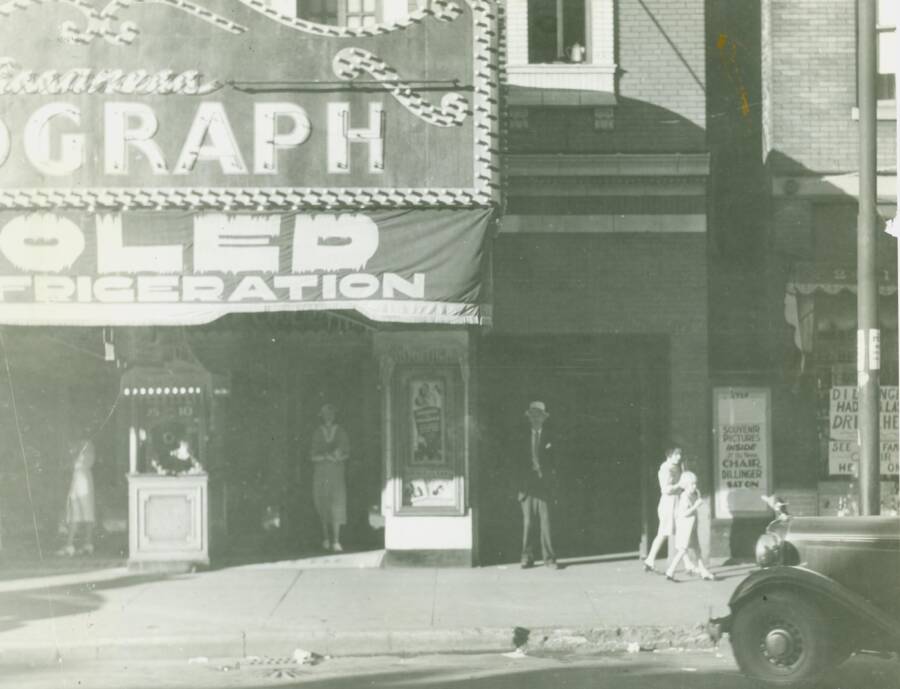
Federal Bureau of InvestigationThe Biograph Theater in Chicago where John Dillinger met his end.
In an unexpected turn of events, the theater’s manager called Chicago police after mistaking the agents for potential robbers. The police tried to arrest the agents before anyone could intervene. However, it wasn’t enough to save Dillinger.
When the movie ended, Dillinger walked out with Hamilton — right past an FBI agent named Melvin Purvis, who lit a cigar to signal the others. According to Purvis’s testimony, Dillinger spotted the signal and turned to look across the street, where the other agents were drawn up.
This was just two months after famous Depression-era robbers Bonnie and Clyde had been machine-gunned to death. Dillinger seemed determined not to die helplessly as they did.
Fishing in his pocket for his Colt pistol, he sprinted across the street to an alley that agents had already blocked off.
Three agents followed him and fired six times, hitting him with four shots. Three shots were superficial. However, the one fired by Agent Charles Winstead entered through the back of Dillinger’s neck, clipped his brain stem, and popped out of his face under his right eye.
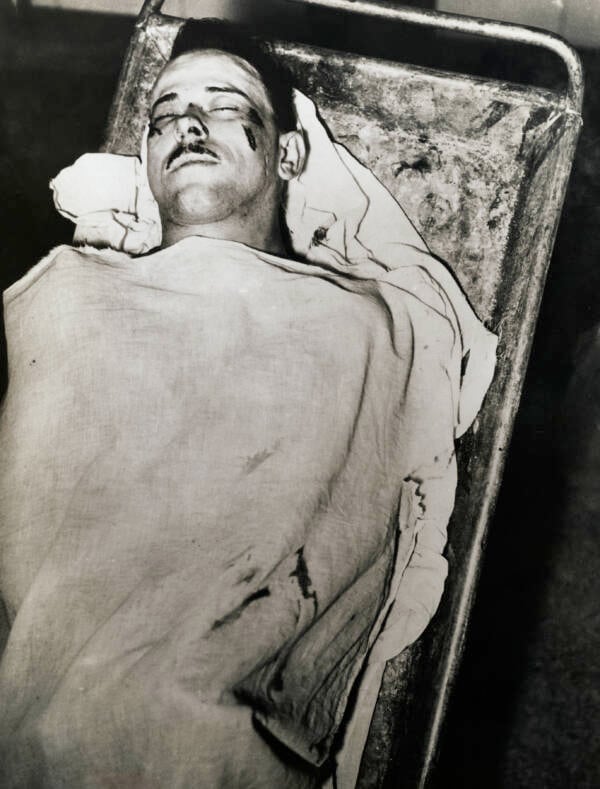
George Rinhart/Corbis/Getty ImagesJohn Dillinger in the morgue, after he was fatally shot by the FBI.
The 31-year-old bank robber was almost certainly dead before his body hit the pavement. According to the FBI, three agents were commended for killing the criminal, though none of them ever came forward to confess which one fired the fatal shot.
John Dillinger’s Legacy In American Popular Culture

Bettmann/Getty ImagesPeople examining Dillinger’s corpse at a morgue in Chicago. By this point, he was quite the celebrity.
After John Dillinger’s death, the criminal was buried in a modest grave in Crown Hill Cemetery in Indiana, where his grave marker has had to be replaced four times — in a fitting tribute, thieves keep stealing pieces of the headstone.
In the following years, many people continued to see him as a Robin Hood-type of character because he robbed the banks that many people held responsible for the Great Depression.
In that sense, many Americans saw him as someone who robbed from the rich to give the the poor — a man of the people.
J. Edgar Hoover did not agree with that assessment. He famously quipped, “I cannot remember a single instance in which John Dillinger fancied himself a knight-errant, obtaining revenge upon a cruel world for past injustices. Rather, he was a cheap, boastful, selfish, tight-fisted pug-ugly, who thought only of himself,” as reported by the Chicago Tribune.
Regardless of who was right, Dillinger’s persona was big enough to inspire the 2009 movie Public Enemies, where he was portrayed by a fellow Midwestern John D. — Johnny Depp.
In total, the life and death of John Dillinger has inspired 14 films as well as several books and television shows — a clear sign that America still hasn’t had enough of the infamous Depression-era criminal.
Next, take a look at the story of Nucky Thompson, the real-life figure behind the acclaimed TV show Boardwalk Empire. Then, learn about the strange bank robbery behind Stockholm Syndrome.





